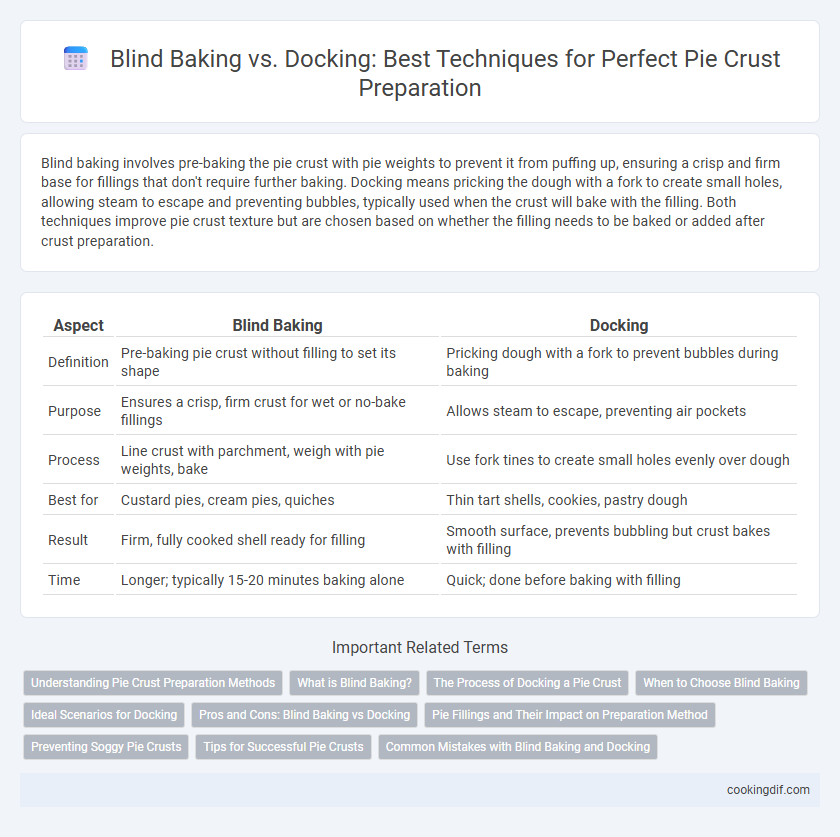Blind baking involves pre-baking the pie crust with pie weights to prevent it from puffing up, ensuring a crisp and firm base for fillings that don't require further baking. Docking means pricking the dough with a fork to create small holes, allowing steam to escape and preventing bubbles, typically used when the crust will bake with the filling. Both techniques improve pie crust texture but are chosen based on whether the filling needs to be baked or added after crust preparation.
Table of Comparison
| Aspect | Blind Baking | Docking |
|---|---|---|
| Definition | Pre-baking pie crust without filling to set its shape | Pricking dough with a fork to prevent bubbles during baking |
| Purpose | Ensures a crisp, firm crust for wet or no-bake fillings | Allows steam to escape, preventing air pockets |
| Process | Line crust with parchment, weigh with pie weights, bake | Use fork tines to create small holes evenly over dough |
| Best for | Custard pies, cream pies, quiches | Thin tart shells, cookies, pastry dough |
| Result | Firm, fully cooked shell ready for filling | Smooth surface, prevents bubbling but crust bakes with filling |
| Time | Longer; typically 15-20 minutes baking alone | Quick; done before baking with filling |
Understanding Pie Crust Preparation Methods
Blind baking involves partially or fully baking the pie crust before adding the filling to prevent sogginess and ensure a crisp texture. Docking refers to poking small holes in the pie dough with a fork to allow steam to escape, avoiding bubbles and uneven rising during baking. Both methods enhance pie crust quality, with blind baking offering structural integrity for wet fillings, while docking is ideal for pies with dry fillings.
What is Blind Baking?
Blind baking is a technique used to pre-bake a pie crust without the filling, preventing sogginess and ensuring a crisp base. It involves lining the crust with parchment paper and filling it with pie weights or dried beans to maintain its shape during baking. This method is essential for custard pies, quiches, and other fillings that require minimal baking time.
The Process of Docking a Pie Crust
Docking a pie crust involves pricking the dough surface with a fork to create small holes that allow steam to escape during baking, preventing bubbles and uneven rising. This technique is essential for recipes requiring a partially baked or fully baked crust without filling, ensuring a flat, even texture. Docking is especially useful in blind baking to maintain the crust's shape while it sets and cooks thoroughly.
When to Choose Blind Baking
Blind baking is essential when preparing pie crusts for recipes with no-bake fillings or custard fillings that require baking after the crust is pre-baked. This method prevents a soggy bottom by firming up the crust before adding softer fillings like cream or pudding. Choose blind baking for pies such as cream pies, cheesecake, or quiches to ensure a crisp, fully cooked crust.
Ideal Scenarios for Docking
Docking is ideal for pies with wet fillings, such as custards or fruit mixtures, where steam release prevents soggy crusts without causing shrinkage. It works best for single-crust pies that don't require a pre-baked shell, maintaining a tender texture while avoiding bubbles. This technique efficiently controls crust puffing during baking, ensuring even browning and a uniform surface.
Pros and Cons: Blind Baking vs Docking
Blind baking ensures a fully cooked, firm pie crust ideal for wet fillings, preventing sogginess, but it requires extra time and careful use of pie weights to avoid puffing. Docking, which involves pricking the dough with a fork to release steam, speeds up baking and reduces puffing without additional tools, but may result in a less sturdy crust that can become soggy with moist fillings. Choosing between blind baking and docking depends on the filling type, desired crust texture, and preparation time available.
Pie Fillings and Their Impact on Preparation Method
Pie fillings with high moisture content, such as fruit or custard, benefit from blind baking to create a crisp, sturdy crust that prevents sogginess. In contrast, dry fillings like nut or chocolate mixtures allow docking to suffice, as it controls air bubbles without over-baking. Choosing between blind baking and docking depends largely on the filling's moisture level, which directly impacts crust texture and structural integrity.
Preventing Soggy Pie Crusts
Blind baking involves pre-baking the pie crust with pie weights or beans to create a crisp, firm base that prevents sogginess from wet fillings. Docking, the technique of poking holes in the dough with a fork, allows steam to escape during baking, reducing bubbles and ensuring an even, dry crust. Combining blind baking and docking techniques effectively prevents soggy pie crusts by minimizing moisture retention and maintaining structural integrity.
Tips for Successful Pie Crusts
Blind baking involves pre-baking the pie crust to prevent a soggy bottom, using pie weights or dried beans to keep the crust from puffing up. Docking creates small holes in the dough that allow steam to escape, helping the crust bake evenly and avoid bubbles. For a perfectly crisp and evenly baked pie crust, combine docking with blind baking, chilling the dough beforehand and using a heavy-duty pie pan for better heat distribution.
Common Mistakes with Blind Baking and Docking
Common mistakes with blind baking include failing to fully cover the crust with parchment paper or pie weights, leading to uneven rising and shrinking. Docking errors often involve pressing too hard, which can create unintended holes that cause filling leakage or an overly dry crust. Both techniques require careful attention to ensure a crisp, evenly baked pie crust without sogginess or cracks.
Blind Baking vs Docking for pie crust preparation Infographic

 cookingdif.com
cookingdif.com